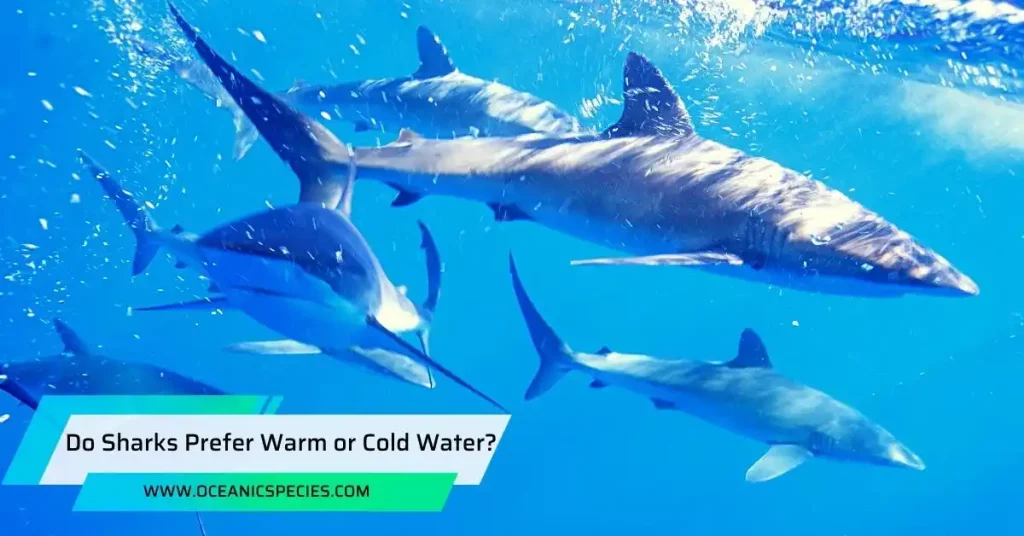Sharks are more commonly found in warmer waters rather than cold waters. Scientists have observed that most shark species prefer water temperatures between 59 to 86 degrees fahrenheit.
However, it is important to note that different shark species have different temperature preferences, and some may tolerate colder or warmer waters depending on their adaptations and geographical distribution. Understanding the temperature preferences of sharks is crucial for their conservation and management, as changes in water temperature can significantly impact their behavior, migratory patterns, and overall ecosystem dynamics.
Understanding The Ideal Water Temperature For Sharks
Do sharks like warm or cold water? The ideal water temperature for sharks depends on the species and their adaptive capabilities. Water temperature affects their distribution, habitat preferences, and behavior in intriguing ways, shaping their fascinating marine world.
The Influence Of Water Temperature On Shark Distribution
Sharks are found in almost every ocean around the world, from cool temperate waters to tropical seas. The distribution of shark species is closely linked to water temperature, as they tend to inhabit areas that suit their thermal preferences.
Some shark species, like the great white shark, are known to prefer cooler waters, while others, such as the tiger shark, thrive in warmer tropical regions. The availability of prey, mating opportunities, and environmental conditions also influence shark distribution beyond just water temperature.
An Overview Of Shark Habitat Preferences
Coastal areas tend to host a wide range of shark species due to the varied water temperatures and abundant food sources found there. Some shark species, like the bull shark, have adapted to survive in both saltwater and freshwater environments, allowing them to inhabit rivers and estuaries.
Cold-water sharks, such as the greenland shark, can be found in the deep, frigid waters of the arctic and subarctic regions. Conversely, warm-water sharks like the hammerhead shark are commonly found in tropical and subtropical regions with higher water temperatures.
Investigating The Impact Of Water Temperature On Shark Behavior
Water temperature not only influences the distribution and habitat preferences of sharks but also plays a significant role in their behavior.
Shark metabolism is directly affected by water temperature, impacting their overall activity levels. Warmer waters tend to accelerate their metabolism, making sharks more active and energetic. Studies have shown that some shark species exhibit migratory behavior, following temperature gradients in search of food and suitable breeding sites.
Breeding patterns can also be influenced by water temperature. For instance, pregnant female sharks often favor warmer waters to give birth to their young, which provides a more favorable environment for their offspring’s survival. It’s important to note that while water temperature is a significant factor in shark behavior, it’s not the sole determinant. Factors like food availability, habitat quality, predation risks, and social interactions also play crucial roles.
Warm-Water Sharks: Thriving In Tropical Paradises
Warm-water sharks are perfectly suited to tropical environments due to the rich biodiversity, coral reefs, and temperature gradients found in these areas. Their ability to adapt to warm waters, metabolic efficiency, and unique behaviors allow them to thrive in these paradises.
Exploring The Rich Biodiversity Of Warm-Water Shark Habitats
- Tropical biodiversity: Tropical waters are teeming with biodiversity, making them a haven for warm-water sharks. The abundance of prey such as fish, crustaceans, and mollusks provides a reliable food source for these apex predators.
- Coral reefs: Warm-water sharks, like the colorful creatures that inhabit coral reefs, are drawn to the intricate ecosystems these underwater structures provide. These remarkable habitats offer shelter, protection, and a vast array of prey for sharks to feast upon.
- Temperature gradient: While warm-water sharks prefer tropical temperatures, they also seek out areas with a slight temperature gradient. This allows them to access warmer regions for breeding and cooler depths for hunting, ensuring a balance between thermoregulation and maximizing feeding opportunities.
Adapting To Life In Warm, Tropical Waters: Mechanisms And Behaviors
- Metabolic efficiency: Warm-water sharks have evolved to thrive in tropical climates by possessing highly efficient metabolisms. This enables them to maintain a heightened level of activity, even in warm water, while conserving energy for essential functions.
- Countercurrent exchange: Some warm-water shark species, such as the tiger shark, possess a unique adaptation called countercurrent exchange. This mechanism allows them to regulate their body temperature by conserving heat in colder seawater and redirecting it to the core.
- Seasonal migration: Many warm-water shark species exhibit seasonal migration patterns to take advantage of the changing conditions in different tropical areas. This allows them to follow prey and find optimal breeding grounds, ensuring their survival and reproductive success.
- Camouflage and hunting strategies: Warm-water sharks have adapted various camouflage techniques to blend into their surroundings. Some species have vertical striping that helps them blend into the light filtering through the tropical waters, making it easier for them to ambush unsuspecting prey.
Cold-Water Sharks: Masters Of The Frigid Seas
In these unique ecosystems, cold-water sharks have developed remarkable adaptations to survive and thrive. Cold-water sharks are truly the masters of the frigid seas, living in habitats that would be unbearable for most other creatures. These sharks have adapted to the extreme conditions and thrive in the icy waters of the oceans.
A Glimpse Into The Unique Ecosystems Of Cold-Water Shark Habitats
In the vast expanses of the cold ocean, cold-water sharks have found their niche. These ecosystems have some distinct features that make them suitable homes for these fascinating creatures:
- Deep, dark waters: Cold-water sharks are found in the deep waters of the ocean, far away from sunlight and warmth. These depths provide a constant, cool environment that the sharks prefer.
- Nutrient-rich waters: The cold waters are teeming with nutrients, thanks to the upwelling of cold, nutrient-rich water from the ocean depths. This abundance of food attracts a variety of prey for the sharks to feed on.
- Benthic environment: Cold-water shark habitats are often located near the seafloor. This benthic environment is home to a diverse range of marine life, such as crustaceans and other fish, which serve as the sharks’ primary food source.
Cold-Water Adaptations: How Sharks Survive In Harsh Conditions
To survive in the bone-chilling waters, cold-water sharks have evolved several adaptations that allow them to endure the harsh conditions:
- Slow metabolism: Cold-water sharks have a slower metabolic rate compared to their warm-water counterparts. This helps them conserve energy and go for extended periods without food.
- Insulation: These sharks have a thick layer of fat, known as blubber, that acts as insulation, keeping them warm in the cold waters and protecting them from the freezing temperatures.
- Counter-current exchange: Special adaptations in their circulatory system allow cold-water sharks to maintain their body temperature. They have a network of blood vessels that transfer heat from the warm, oxygenated blood to the cold, deoxygenated blood flowing back to the heart, minimizing heat loss.
- Efficient hunting techniques: Cold-water sharks are skilled hunters, with sharp senses and excellent maneuverability. They rely on stealth and ambush to catch their prey in the dark depths, where visibility is limited.
Contrasting Habitats: Warm Vs. Cold-Water Environments
The contrasting habitats of warm and cold water play a significant role in shaping the characteristics and behaviors of shark species. While warm-water sharks are known for their size, aggression, and thriving populations, cold-water sharks have unique adaptations to survive in freezing temperatures.
Examining The Differences In Shark Species Between Warm And Cold Waters
In warm water, you’ll find a diverse range of shark species, such as the tiger shark, bull shark, and great white shark. These warm-water sharks are typically larger in size and have a faster metabolism compared to their cold-water counterparts. Warm-water sharks are known for their aggression and higher activity levels, making them formidable predators in their ecosystems. Due to the abundance of prey and favorable conditions, warm-water shark populations tend to be more stable compared to cold-water species.
Unique Characteristics And Behaviors Of Warm-Water Shark Species
Warm-water sharks have a higher body temperature, allowing them to thrive in tropical and subtropical regions. These sharks exhibit unique behaviors such as breaching, where they propel their bodies out of the water, often observed in great white sharks. Warm-water shark species are known to migrate long distances to reach mating and feeding grounds, showcasing their adaptability and survival skills. Some warm-water shark species, like the bull shark, are even capable of surviving in freshwater environments for extended periods.
Cold-Water Sharks: Discovering The Remarkable Adaptations Of Polar Species
Cold-water environments are home to fascinating shark species like the greenland shark, the sleeper shark, and the frilled shark. These sharks have evolved remarkable adaptations to survive in freezing temperatures, such as a lower body temperature and a slower metabolism. Cold-water sharks often have a more streamlined body shape, allowing them to navigate through icy waters with ease. Unlike their warm-water counterparts, cold-water sharks have a slower growth rate and reproductive cycle, making them more susceptible to environmental changes and threats.
Factors Influencing Shark Habitat Preferences
The preference of sharks for warm or cold water is ultimately determined by a complex combination of factors. While some shark species are more commonly associated with warm or cold waters, it is important to remember that their habitat preferences are influenced by a variety of factors, including ocean currents and water temperature.
Ocean Currents: The Role Of Warm And Cold Water Circulation
Ocean currents play a crucial role in shaping the distribution and migration patterns of sharks. These powerful streams of water can be driven by various factors, including wind, temperature differences, and the rotation of the earth. There are two main types of ocean currents: warm and cold.
How Ocean Currents Affect Shark Migration And Distribution
Sharks are highly mobile creatures that rely on ocean currents for several reasons. Here are key points to consider:
- Migration: Many shark species undertake long-distance migrations in search of food, mates, or suitable habitats. They often follow specific ocean currents that provide energy-efficient pathways for traveling.
- Foraging opportunities: Ocean currents can transport prey items and nutrients, creating areas of high food abundance. Sharks, being opportunistic feeders, are attracted to these areas and concentrate their efforts there.
- Reproduction and nursery areas: Some shark species depend on specific ocean currents to reach their preferred breeding and nursery grounds. These currents provide favorable conditions for growth and development, ensuring the survival of the next generation.
- Dispersal of juveniles: Ocean currents also aid in the dispersal of juvenile sharks, helping them to establish new territories and reduce competition with their siblings.
The Connection Between Water Temperature And Ocean Currents
Water temperature is intimately linked to the formation and movement of ocean currents. Here are key points to consider:
- Warm and cold water currents: The temperature difference between two bodies of water is one of the driving forces behind the formation of ocean currents. Warm water tends to flow towards colder regions, while cold water flows towards warmer areas.
- Thermohaline circulation: Another important factor in ocean circulation is the difference in water density caused by variations in temperature and salinity. This process, known as thermohaline circulation, brings warm water from the equator to the poles and cold water from the poles to the equator.
- El niño and la niña: The climate phenomena known as el niño and la niña can have a significant impact on ocean currents. El niño events, characterized by warmer water in the pacific ocean, can disrupt currents and alter shark migration patterns.
Environmental Changes: Implications For Shark Habitats
Understanding the implications of environmental changes on shark habitats is crucial for the conservation and management of these fascinating creatures. By taking proactive measures to mitigate the effects of climate change and protect vulnerable shark species, we can ensure their survival for generations to come.
Climate Change: Impact On Shark Populations And Habitats
Climate change is a phenomenon that affects all aspects of our planet, and shark populations and habitats are no exception. Here are key points to consider:
- Increasing water temperatures: Rising global temperatures have a significant impact on the habitats of many shark species. As the water warms up, it can lead to changes in the distribution and abundance of prey species, affecting the behavior and feeding patterns of sharks.
- Ocean acidification: Climate change also contributes to increasing levels of carbon dioxide in the atmosphere, which in turn leads to more acidic oceans. This can have detrimental effects on the marine food web, disrupting the availability of food for sharks.
- Rising sea levels: With the melting of polar ice caps and glaciers, sea levels are on the rise. This directly impacts coastal habitats where many shark species rely on for breeding and nursery areas. As these areas become submerged, it can result in the loss of important shark habitats.
- Extreme weather events: Climate change is also associated with an increase in extreme weather events such as hurricanes and storms. These events can cause habitat destruction, disrupt migration patterns, and lead to the displacement of shark populations.
The Effects Of Warming Oceans On Shark Behavior And Population Dynamics
Warming oceans due to climate change can have profound effects on the behavior and population dynamics of sharks. Consider the following:
- Changes in feeding behavior: Rising water temperatures can alter the abundance and distribution of prey species, leading to changes in the feeding behaviors of sharks. They may need to seek new prey sources or adapt to changes in migration patterns of their usual food sources.
- Shifts in migration patterns: Some shark species migrate long distances to find favorable feeding and breeding grounds. Warming oceans can disrupt these migration patterns, as the distribution of food and optimal temperatures may shift. This can result in sharks venturing into new territories or struggling to find suitable habitats along their usual routes.
- Impacts on reproduction: Many shark species rely on specific temperature conditions for successful reproductive processes. With warming oceans, these conditions may change, affecting the timing and success rates of breeding. This can ultimately impact the population dynamics of sharks.
- Behavioral changes: Sharks are highly evolved and adaptable predators. In response to warming oceans, some species may exhibit new behaviors, such as seeking out cooler, deeper waters or adjusting their feeding strategies. These behavioral shifts are crucial for the survival of sharks in a changing environment.
Cold-Water Sharks At Risk: Examining The Vulnerabilities Of Polar Species
While much attention is given to the impacts of warming on shark populations, cold-water shark species also face unique challenges. Here are some vulnerabilities of polar species:
- Dwindling ice habitat: Polar species such as greenland sharks and arctic skates rely on icy environments for habitat and food sources. As these icy habitats shrink due to melting, these species lose vital areas for reproduction, feeding, and shelter.
- Impacts on prey availability: Cold-water sharks depend on specific prey species that are adapted to these extreme environments. With melting ice and rising temperatures, the availability and distribution of these prey species can decline, potentially affecting the survival of polar sharks.
- Threats from shipping and oil exploration: As ice recedes in polar regions, new opportunities for shipping and oil exploration arise. This brings increased human activity to these areas, potentially leading to collisions with ships, pollution, and habitat disturbance for polar shark species.
- Reduced genetic diversity: Polar shark populations are often small and isolated due to their remote habitats. This limited genetic diversity makes them vulnerable to environmental changes and reduces their ability to adapt to shifting conditions.
Frequently Asked Questions
How Does Water Temperature Affect Shark Behavior?
Water temperature plays a crucial role in determining shark behavior, affecting their metabolism, feeding habits, and migration patterns.
Are There Certain Shark Species That Prefer Warmer Waters?
Yes, some shark species, like the hammerhead and bull shark, are known to favor warm tropical waters.
Can Sharks Survive In Freezing Cold Water?
While most sharks prefer warmer waters, some species, such as the greenland shark, can survive in freezing cold waters due to their unique adaptations.
Does Water Temperature Influence The Distribution Of Shark Species?
Definitely! Water temperature is a key factor in determining where certain shark species are found, shaping their geographical distribution around the world.
Conclusion
Overall, it is clear that sharks have complex preferences when it comes to water temperature. While some species are known to favor warmer waters, others thrive in colder environments. Factors such as habitat, prey availability, and reproductive needs drive their affinity for specific temperatures.
The ability of sharks to regulate their body temperature also plays a crucial role in their adaptation to different environments. Despite these variations, it is important to note that sharks are highly adaptable creatures, capable of traversing various water temperatures for survival.
Whether it’s warm or cold, sharks have proved their resilience and adaptability, making them one of the most fascinating species on our planet.





